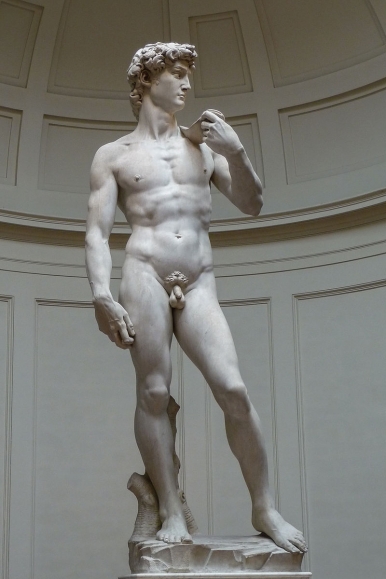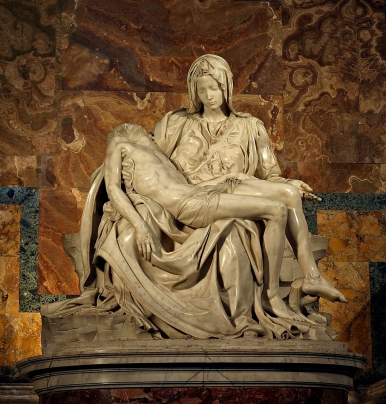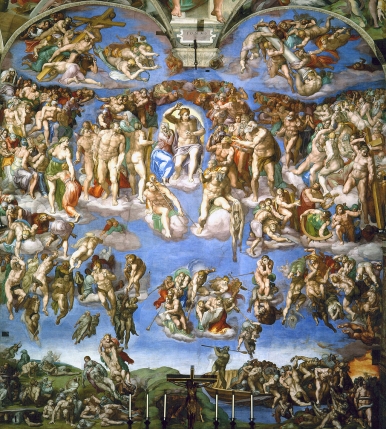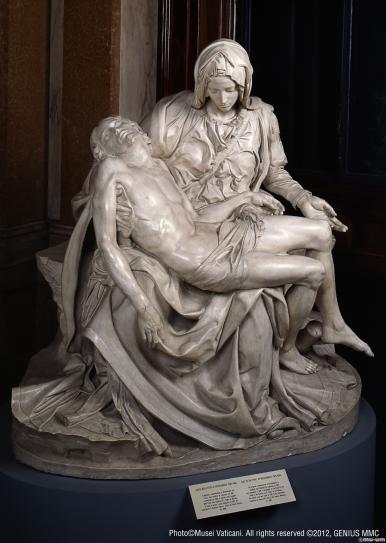미켈란젤로 부오나로티(Michelangelo di Lodovico Buonarroti Simoni)FOLLOW
1475년03월06일 이탈리아 로마 출생 - 1564년02월18일
이탈리아에서 활동
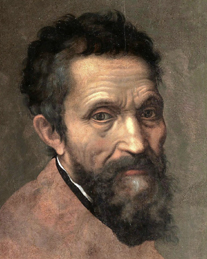
단체전
2012 바티칸 박물관전, 예술의전당 한가람미술관, 서울
추가정보
미켈란젤로는 이미 당대인들 사이에서 천재적 예술가로 끊임없이 찬양되었지만 정작 그 스스로는 늘 예술에 대해 갈등하며 심적 고통을 겪었다. 그의 긴 생애동안 미술의 양식이 여러 번 바뀌었는데, 그 변화의 주인공은 바로 그 자신이었다. 그가 미술에 입문했을 때 초기 르네상스가 한참이었으나 그로 인해 르네상스는 전성기 르네상스로 바뀌었고, 전성기 르네상스가 채 30년도 가기 전에 그의 제자들은 그의 정신을 이어받아 매너리즘 양식을 탄생시켰다. 이후 그의 회화는 다가올 바로크적 특성까지 두루 보여주었는데, 이런 그의 작품은 당대인들에게 인간의 것이 아닌 신의 것으로 여겨지질 정도였다. 이것은 그가 늘 새로운 경향을 실험하고 오직 작품제작에만 몰입했던 결과 일 것이다.
Michelangelo di Lodovico Buonarroti Simoni (6 March 1475 – 18 February 1564), commonly known as Michelangelo, was an Italian Renaissance painter, sculptor, architect, poet, and engineer. Despite making few forays beyond the arts, his versatility in the disciplines he took up was of such a high order that he is often considered a contender for the title of the archetypal Renaissance man, along with his rival and fellow Italian Leonardo da Vinci.
Michelangelo's output in every field during his long life was prodigious; when the sheer volume of correspondence, sketches, and reminiscences that survive is also taken into account, he is the best-documented artist of the 16th century. Two of his best-known works, the Pietà and David, were sculpted before he turned thirty. Despite his low opinion of painting, Michelangelo also created two of the most influential works in fresco in the history of Western art: the scenes from Genesis on the ceiling and The Last Judgment on the altar wall of the Sistine Chapel in Rome. As an architect, Michelangelo pioneered the Mannerist style at the Laurentian Library. At 74 he succeeded Antonio da Sangallo the Younger as the architect of Saint Peter's Basilica. Michelangelo transformed the plan, the western end being finished to Michelangelo's design, the dome being completed after his death with some modification.
In a demonstration of Michelangelo's unique standing, he was the first Western artist whose biography was published while he was alive.Two biographies were published of him during his lifetime; one of them, by Giorgio Vasari, proposed that he was the pinnacle of all artistic achievement since the beginning of the Renaissance, a viewpoint that continued to have currency in art history for centuries. In his lifetime he was also often called Il Divino ("the divine one").One of the qualities most admired by his contemporaries was his terribilità, a sense of awe-inspiring grandeur, and it was the attempts of subsequent artists to imitate Michelangelo's impassioned and highly personal style that resulted in Mannerism, the next major movement in Western art after the High Renaissance.
Early life
Michelangelo was born on 6 March 1475 in Caprese near Arezzo, Tuscany. His family had for several generations been small-scale bankers in Florence but his father, Lodovico di Leonardo di Buonarroti di Simoni, failed to maintain the bank's financial status, and held occasional government positions. At the time of Michelangelo's birth, his father was the Judicial administrator of the small town of Caprese and local administrator of Chiusi. Michelangelo's mother was Francesca di Neri del Miniato di Siena. The Buonarrotis claimed to descend from the Countess Mathilde of Canossa; this claim remains unproven, but Michelangelo himself believed it. Several months after Michelangelo's birth the family returned to Florence where Michelangelo was raised. At later times, during the prolonged illness and after the death of his mother when he was seven years old, Michelangelo lived with a stonecutter and his wife and family in the town of Settignano where his father owned a marble quarry and a small farm. Giorgio Vasari quotes Michelangelo as saying, "If there is some good in me, it is because I was born in the subtle atmosphere of your country of Arezzo. Along with the milk of my nurse I received the knack of handling chisel and hammer, with which I make my figures."
Michelangelo's father sent him to study grammar with the Humanist Francesco da Urbino in Florence as a young boy. The young artist, however, showed no interest in his schooling, preferring to copy paintings from churches and seek the company of painters. At thirteen, Michelangelo was apprenticed to the painter Domenico Ghirlandaio. When Michelangelo was only fourteen, his father persuaded Ghirlandaio to pay his apprentice as an artist, which was highly unusual at the time. When in 1489 Lorenzo de' Medici, de facto ruler of Florence, asked Ghirlandaio for his two best pupils, Ghirlandaio sent Michelangelo and Francesco Granacci. From 1490 to 1492, Michelangelo attended the Humanist academy which the Medici had founded along Neo Platonic lines. Michelangelo studied sculpture under Bertoldo di Giovanni. At the academy, both Michelangelo's outlook and his art were subject to the influence of many of the most prominent philosophers and writers of the day including Marsilio Ficino, Pico della Mirandola and Angelo Poliziano. At this time Michelangelo sculpted the reliefs Madonna of the Steps (1490–1492) and Battle of the Centaurs (1491–1492). The latter was based on a theme suggested by Poliziano and was commissioned by Lorenzo de Medici. While both were apprenticed to Bertoldo di Giovanni, Pietro Torrigiano struck the 17 year old on the nose, and thus caused that disfigurement which is so conspicuous in all the portraits of Michelangelo.
Early adulthood
Lorenzo de' Medici's death on 8 April 1492, brought a reversal of Michelangelo's circumstances.
Michelangelo left the security of the Medici court and returned to his father's house. In the following months he carved a wooden crucifix (1493), as a gift to the prior of the Florentine church of Santo Spirito, who had permitted him some studies of anatomy on the corpses of the church's hospital. Between 1493 and 1494 he bought a block of marble for a larger than life statue of Hercules, which was sent to France and subsequently disappeared sometime circa 1700s. On 20 January 1494, after heavy snowfalls, Lorenzo's heir, Piero de Medici commissioned a snow statue, and Michelangelo again entered the court of the Medici.
In the same year, the Medici were expelled from Florence as the result of the rise of Savonarola. Michelangelo left the city before the end of the political upheaval, moving to Venice and then to Bologna. In Bologna he was commissioned to finish the carving of the last small figures of the Shrine of St. Dominic, in the church dedicated to that saint. Towards the end 1494, the political situation in Florence was calmer. The city, previously under threat from the French, was no longer in danger as Charles VIII had suffered defeats. Michelangelo returned to Florence but received no commissions from the new city government under Savonarola. He returned to the employment of the Medici. During the half year he spent in Florence he worked on two small statues, a child St. John the Baptist and a sleeping Cupid. According to Condivi, Lorenzo di Pierfrancesco de' Medici, for whom Michelangelo had sculpted St. John the Baptist, asked that Michelangelo "fix it so that it looked as if it had been buried" so he could "send it to Rome…pass an ancient work and…sell it much better." Both Lorenzo and Michelangelo were unwittingly cheated out of the real value of the piece by a middleman. Cardinal Raffaele Riario, to whom Lorenzo had sold it, discovered that it was a fraud, but was so impressed by the quality of the sculpture that he invited the artist to Rome.This apparent success in selling his sculpture abroad as well as the conservative Florentine situation may have encouraged Michelangelo to accept the prelate's invitation.
Michelangelo's Pietà, a depiction of the body of Jesus on the lap of his mother Mary after the Crucifixion, was carved in 1499, when the sculptor was 24 years old.Rome
Michelangelo arrived in Rome 25 June 1496 at the age of 21. On 4 July of the same year, he began work on a commission for Cardinal Raffaele Riario, an over-life-size statue of the Roman wine god, Bacchus. However, upon completion, the work was rejected by the cardinal, and subsequently entered the collection of the banker Jacopo Galli, for his garden.
In November of 1497, the French ambassador in the Holy See commissioned one of his most famous works, the Pietà and the contract was agreed upon in August of the following year. The contemporary opinion about this work — "a revelation of all the potentialities and force of the art of sculpture" — was summarized by Vasari: "It is certainly a miracle that a formless block of stone could ever have been reduced to a perfection that nature is scarcely able to create in the flesh."
In Rome, Michelangelo lived near the church of Santa Maria di Loreto. Here, according to the legend, he fell in love with Vittoria Colonna, marquise of Pescara and a poet.[citation needed] His house was demolished in 1874, and the remaining architectural elements saved by the new proprietors were destroyed in 1930. Today a modern reconstruction of Michelangelo's house can be seen on the Gianicolo hill. It is also during this period that skeptics allege Michelangelo executed the scultpure Laocoön and His Sons which resides in the Vatican.

